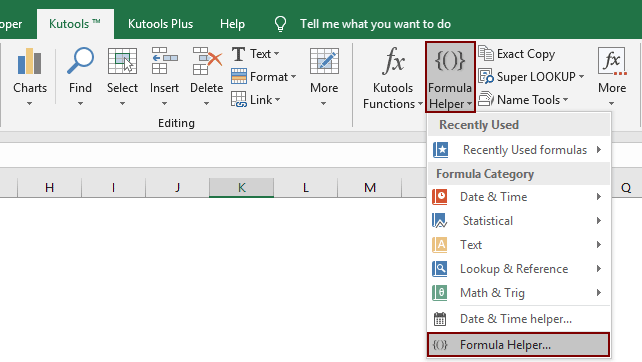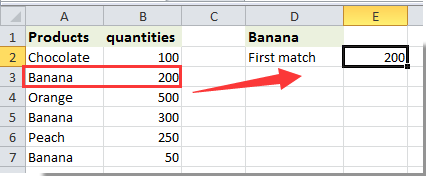¿Cómo buscar con vlookup el primer, segundo o enésimo valor de coincidencia en Excel?
Supongamos que tiene dos columnas con Productos y cantidades como se muestra a continuación. Para averiguar rápidamente las cantidades del primer o segundo plátano, ¿qué harías?

Aquí, la función vlookup puede ayudarlo a lidiar con este problema. En este artículo, le mostraremos cómo buscar con vlookup el primer, segundo o n-ésimo valor de coincidencia con la función Vlookup en Excel.
Vlookup encuentra el primer, segundo o enésimo valor de coincidencia en Excel con fórmula
Vlookup encuentra fácilmente el primer valor de coincidencia en Excel con Kutools para Excel
Vlookup encuentra el primer, segundo o enésimo valor de coincidencia en Excel
Haga lo siguiente para encontrar el primer, segundo o enésimo valor de coincidencia en Excel.
1. En la celda D1, ingrese los criterios que desea visualizar, aquí ingrese Banana.
2. Aquí encontraremos el primer valor de coincidencia de banana. Seleccione una celda en blanco como E2, copie y pegue la fórmula =INDEX($B$2:$B$6,MATCH(TRUE,EXACT($D$1,$A$2:$A$6),0)) en la barra de fórmulas y luego presione Ctrl + Shift + Participar llaves al mismo tiempo

Note: En esta fórmula, $ B $ 2: $ B $ 6 es el rango de los valores coincidentes; $ A $ 2: $ A $ 6 es el rango con todos los criterios para vlookup; $ D $ 1 es la celda que contiene los criterios de vlookup especificados.
Luego, obtendrá el primer valor de coincidencia de banana en la celda E2. Con esta fórmula, solo puede obtener el primer valor correspondiente según sus criterios.
Para obtener cualquier enésimo valor relativo, puede aplicar la siguiente fórmula: =INDEX($B$2:$B$6,SMALL(IF($D$1=$A$2:$A$6,ROW($A$2:$A$6)-ROW($A$2)+1),1)) + Ctrl + Shift + Participar claves juntas, esta fórmula devolverá el primer valor coincidente.
Notas:
1. Para encontrar el segundo valor de coincidencia, cambie la fórmula anterior a =INDEX($B$2:$B$6,SMALL(IF($D$1=$A$2:$A$6,ROW($A$2:$A$6)-ROW($A$2)+1),2))y luego presione Ctrl + Shift + Participar teclas simultáneamente. Ver captura de pantalla:

2. El último número en la fórmula anterior significa el enésimo valor de coincidencia de los criterios de vlookup. Si lo cambia a 3, obtendrá el tercer valor de coincidencia y, si cambia an, se encontrará el enésimo valor de coincidencia.
Vlookup encuentra el primer valor de coincidencia en Excel con Kutools para Excel
YPuede encontrar fácilmente el primer valor de coincidencia en Excel sin recordar fórmulas con el Busque un valor en la lista fórmula fórmula de Kutools for Excel.
Antes de aplicar Kutools for Excel, Por favor descargarlo e instalarlo en primer lugar.
1. Seleccione una celda para ubicar el primer valor coincidente (dice celda E2) y luego haga clic en Kutools > Ayudante de fórmula > Ayudante de fórmula. Ver captura de pantalla:

3. En el Ayudante de fórmula cuadro de diálogo, configure de la siguiente manera:
- 3.1 En el Elige una fórmula cuadro, busque y seleccione Busque un valor en la lista;
Tips: Puede comprobar el Filtrar cuadro, ingrese cierta palabra en el cuadro de texto para filtrar la fórmula rápidamente. - 3.2 En el Matriz de tabla cuadro, seleccione el tabla que contiene los primeros valores coincidentes.;
- 3.2 En el Valor de búsqueda cuadro, seleccione la celda que contiene el criterios devolverá el primer valor basado en;
- 3.3 En el Columna , especifique la columna de la que devolverá el valor coincidente. O puede ingresar el número de columna en el cuadro de texto directamente según lo necesite.
- 3.4 Haga clic en OK botón. Ver captura de pantalla:

Ahora el valor de celda correspondiente se completará automáticamente en la celda C10 según la selección de la lista desplegable.

Si desea tener una prueba gratuita (30 días) de esta utilidad, haga clic para descargarloy luego vaya a aplicar la operación según los pasos anteriores.
Las mejores herramientas de productividad de oficina
Mejore sus habilidades de Excel con Kutools for Excel y experimente la eficiencia como nunca antes. Kutools for Excel ofrece más de 300 funciones avanzadas para aumentar la productividad y ahorrar tiempo. Haga clic aquí para obtener la función que más necesita...

Office Tab lleva la interfaz con pestañas a Office y hace que su trabajo sea mucho más fácil
- Habilite la edición y lectura con pestañas en Word, Excel, PowerPoint, Publisher, Access, Visio y Project.
- Abra y cree varios documentos en nuevas pestañas de la misma ventana, en lugar de en nuevas ventanas.
- ¡Aumenta su productividad en un 50% y reduce cientos de clics del mouse todos los días!
